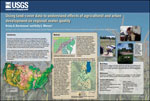The Land-Cover Trends project is a collaborative effort between the Geographic Analysis and Monitoring Program of the U.S. Geological Survey (USGS), the U.S. Environmental Protection Agency (EPA) and the National Aeronautics and Space Administration (NASA) to understand the rates, trends, causes, and consequences of contemporary land-use and land-cover change in the United States. The data produced from this research can lead to an enriched understanding of the drivers of future landuse change, effects on environmental systems, and any associated feedbacks.
USGS scientists are using the EPA Level III ecoregions as the geographic framework to process geospatial data collected between 1973 and 2000 to characterize ecosystem responses to land-use changes. General land-cover classes for these periods were interpreted from Landsat Multispectral Scanner, Thematic Mapper, and Enhanced Thematic Mapper Plus imagery to categorize and evaluate land-cover change using a modified Anderson Land-Use/Land-Cover Classification System for image interpretation.


